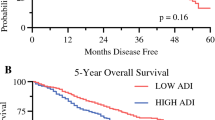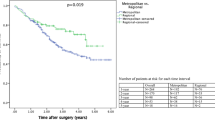Abstract
Background
The impact of distance traveled on cytoreductive surgery (CRS) and hyperthermic intraperitoneal chemotherapy (HIPEC) outcomes needs further investigation.
Methods
This retrospective study reviewed a prospectively managed single-center CRS/HIPEC 1992–2022 database. Zip codes were used to calculate distance traveled and to obtain data on income and education via census data. Patients were separated into three groups based on distance traveled in miles (local: ≤50 miles, regional: 51–99 miles, distant: ≥100 miles). Descriptive statistics, Kaplan-Meier method, and Cox regression were performed.
Results
The 1614 patients in the study traveled a median distance of 109.5 miles (interquartile range [IQR], 53.36–202.29 miles), with 23% traveling locally, 23.9% traveling regionally, and 53% traveling distantly. Those traveling distantly or regionally tended to be more white (distant: 87.8%, regional: 87.2%, local: 83.2%), affluent (distant: $61,944, regional: $65,014, local: $54,390), educated (% without high school diploma: distant: 10.6%, regional: 11.5%, local: 13.0%), less often uninsured (distant: 2.3%, regional: 4.6%, local: 5.2%) or with Medicaid (distant: 3.3%, regional: 1.3%, local: 9.7%). They more often had higher Peritoneal Carcinomatosis Index (PCI) scores (distant: 15.4, regional: 15.8, local: 12.7) and R2 resections (distant: 50.3%, regional: 52.2%, local: 40.5%). Median survival did not differ between the groups, and distance traveled was not a predictor of survival.
Conclusion
More than 50% of the patients traveled farther than 100 miles for treatment. Although regionalization of CRS/HIPEC may be appropriate given the lack of survival difference based on distance traveled, those who traveled further had fewer health care disparities but higher PCI scores and more R2 resections, which raises concerns about access to care for the underserved, time to treatment, and surgical quality.


Similar content being viewed by others
References
Rajeev R, Klooster B, Turaga KK. Impact of surgical volume of centers on postoperative outcomes from cytoreductive surgery and hyperthermic intra-peritoneal chemoperfusion. J Gastrointest Oncol. 2016;7:122–8.
Wasif N, Chang YH, Pockaj BA, Gray RJ, Mathur A, Etzioni D. Association of distance traveled for surgery with short- and long-term cancer outcomes. Ann Surg Oncol. 2016;23:3444–52.
Massarweh NN, Chiang YJ, **ng Y, Chang GJ, Haynes AB, You YN, et al. Association between travel distance and metastatic disease at diagnosis among patients with colon cancer. J Clin Oncol. 2014;32:942–8.
Graboyes EM, Ellis MA, Li H, Kaczmar JM, Sharma AK, Lentsch EJ, et al. Racial and ethnic disparities in travel for head and neck cancer treatment and the impact of travel distance on survival. Cancer. 2018;124:3181–91.
Noiret B, Clement G, Lenne X, Bruandet A, Glehen O, Voron T, et al. Centralization and oncologic training reduce postoperative morbidity and failure-to-rescue rates after cytoreductive surgery and hyperthermic intraperitoneal chemotherapy for peritoneal surface malignancies: study on a 10-year national French practice. Ann Surg. 2020;272:847–54.
Rog CJ, Lucas G, Reiter S, Vetto S, Alassas M, Ong ES. Optimal oncologic and perioperative outcomes of cytoreductive surgery with hyperthermic intraperitoneal chemotherapy are attainable at a community center. Am J Surg. 2021;221:1200–2.
Nikiforchin A, Gushchin V, King MC, Baron E, Nieroda C, Sittig M, et al. Surgical and oncological outcomes after cytoreductive surgery and hyperthermic intraperitoneal chemotherapy at a nonacademic center: 25-year experience. J Surg Oncol. 2021;123:1030–44.
United States Census Bureau, American Community Survey, United States government. Retrieved 22 December 2022 at https://www.census.gov/programs-surveys/acs.
Pednekar P, Peterson A. Map** pharmacy deserts and determining accessibility to community pharmacy services for elderly enrolled in a State Pharmaceutical Assistance Program. PLoS One. 2018;13:e0198173.
LaVela SL, Smith B, Weaver FM, Miskevics SA. Geographical proximity and health care utilization in veterans with SCI&D in the USA. Soc Sci Med. 2004;59:2387–99.
Sinnott RW. Astronomical computing: virtues of the Haversine. Sky Telescope. 1984;68:159.
Chambers LM, Yao M, Morton M, Gruner M, Chichura A, Costales AB, et al. Assessment of travel distance for hyperthermic intraperitoneal chemotherapy in women with ovarian cancer. Gynecol Oncol Rep. 2022;40:100951.
Cui, Weiwei, Flow map, Microsoft AppSource, accessed 22 December 2022, https://appsource.microsoft.com/en-us/product/office/WA104380901?
Vetterlein MW, Löppenberg B, Karabon P, Dalela D, **dal T, Sood A, et al. Impact of travel distance to the treatment facility on overall mortality in U.S. patients with prostate cancer. Cancer. 2017;123:3241–52.
Speicher PJ, Englum BR, Ganapathi AM, Wang X, Hartwig MG, D’Amico TA, et al. Traveling to a high-volume center is associated with improved survival for patients with esophageal cancer. Ann Surg. 2017;265:743–9.
Beal EW, Mehta R, Merath K, Tsilimigras DI, Hyer JM, Paredes A, et al. Outcomes after resection of hepatocellular carcinoma: intersection of travel distance and hospital volume. J Gastrointest Surg. 2019;23:1425–34.
Tabrizian P, Overbey J, Carrasco-Avino G, Bagiella E, Labow DM, Sarpel U. Escalation of socioeconomic disparities among patients with colorectal cancer receiving advanced surgical treatment. Ann Surg Oncol. 2015;22:1746–50.
Rieser CJ, Hoehn RS, Zenati M, Hall LB, Kang E, Zureikat AH, et al. Impact of socioeconomic status on presentation and outcomes in colorectal peritoneal metastases following cytoreduction and chemoperfusion: persistent inequalities in outcomes at a high-volume center. Ann Surg Oncol. 2021;28:3522–31.
Byrne RM, Gilbert EW, Dewey EN, Herzig DO, Lu KC, Billingsley KG, et al. Who undergoes cytoreductive surgery and perioperative intraperitoneal chemotherapy for appendiceal cancer? An analysis of the National Cancer Database. J Surg Res. 2019;238:198–206.
Marulanda K, Maduekwe UN. Disparities in the management of peritoneal surface malignancies. Surg Oncol Clin North Am. 2022;31:29–41.
Cline M. (25 May 2003). "15 Things We Learned from the New 2020 Census Data" North Carolina Office of State Budget and Management." North Carolina Office of State Budget and Management. <https://www.osbm.nc.gov/blog/2023/05/25/15-things-we-learned-new-2020-census-data>. Accessed 11 August 2023.
Henley SJ, Jemal A. Rural cancer control: bridging the chasm in geographic health inequity. Cancer Epidemiol Biomarkers Prev. 2018;27:1248–51.
Yabroff KR, Han X, Zhao J, Nogueira L, Jemal A. Rural cancer disparities in the United States: a multilevel framework to improve access to care and patient outcomes. JCO Oncol Pract. 2020;16:409–13.
Baldwin LM, Cai Y, Larson EH, Dobie SA, Wright GE, Goodman DC, et al. Access to cancer services for rural colorectal cancer patients. J Rural Health. 2008;24:390–9.
Diaz A, Burns S, Paredes AZ, Pawlik TM. Accessing surgical care for pancreaticoduodenectomy: patient variation in travel distance and choice to bypass hospitals to reach higher volume centers. J Surg Oncol. 2019;120:1318–26.
Payne S, Jarrett N, Jeffs D. The impact of travel on cancer patients’ experiences of treatment: a literature review. Eur J Cancer Care England. 2000;9:197–203.
Alvino DML, Chang DC, Adler JT, Noorbakhsh A, ** G, Mullen JT. How far are patients willing to travel for gastrectomy? Ann Surg. 2017;265:1172–7.
Mujumdar V, Butler TR, Shalowitz DI. A qualitative study on the impact of long-distance travel for gynecologic cancer care. Gynecol Oncol Rep. 2021;38:100868.
Acknowledgments
The authors acknowledge the support of the Wake Forest Baptist Comprehensive Cancer Center Biostatistics Shared Resource by the National Cancer Institute’s Cancer Center Support Grant (award no. P30CA012197). The content is solely the responsibility of the authors and does not necessarily represent the official views of the National Cancer Institute.
Author information
Authors and Affiliations
Corresponding author
Ethics declarations
Disclosure
The authors declare that they have no conflict of interest.
Additional information
Publisher's Note
Springer Nature remains neutral with regard to jurisdictional claims in published maps and institutional affiliations.
Poster presentations at the 2023 Advanced Cancer Therapies meeting, San Diego, California, 18–20 February 202,3 and the Society for Surgical Oncology International Conference on Surgical Cancer Care at Boston, Massachusetts, 22–25 March 2023.
Rights and permissions
Springer Nature or its licensor (e.g. a society or other partner) holds exclusive rights to this article under a publishing agreement with the author(s) or other rightsholder(s); author self-archiving of the accepted manuscript version of this article is solely governed by the terms of such publishing agreement and applicable law.
About this article
Cite this article
Solsky, I., Patel, A., Leonard, G. et al. Distance Traveled and Disparities in Patients Undergoing Cytoreductive Surgery and Hyperthermic Intraperitoneal Chemotherapy. Ann Surg Oncol 31, 1035–1048 (2024). https://doi.org/10.1245/s10434-023-14469-1
Received:
Accepted:
Published:
Issue Date:
DOI: https://doi.org/10.1245/s10434-023-14469-1







